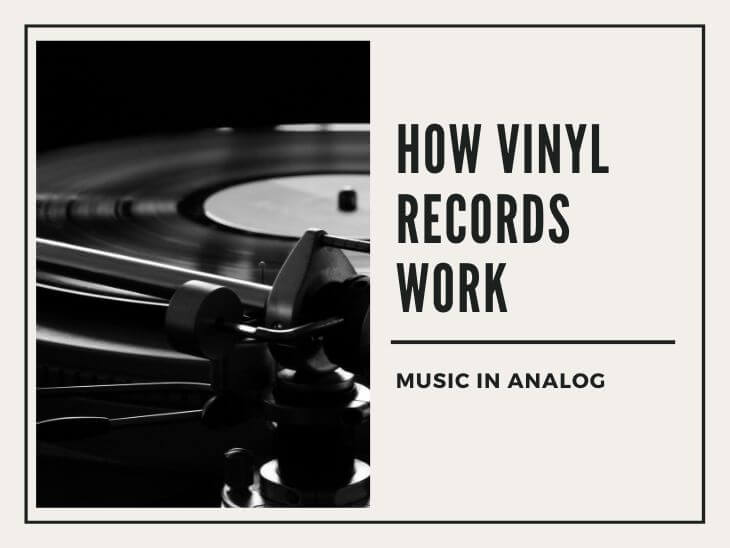How do Vinyl Records work?
Despite the rise of digital media in the music world, vinyl has also made a comeback among audiophiles.
If you love to enjoy music in the old-fashioned way then probably, you own or are willing to own a record player to play your favorite record.
Moreover, my curiosity drives me to think, about how this thing even works i.e. how the vinyl record produces such mesmerizing melodies.
The functioning of the vinyl record is complex but fascinating and gives you a learning experience on so many things at the same time.
In this article, you will get information about the working of sound waves, different parts of turntable setup, and finally the working of vinyl records.

How sound is heard?
Before going on to the working of vinyl records first, we need to understand, how we hear the sound of anything. To understand the workings of the sound, you don’t need to be a physics nerd but requires a little bit of awareness.
Sound is produced when an object vibrates the air around it, and this vibration can be represented as a wave that travels through any medium. Sound can travel through any medium whether it is solid, liquid, or gas.
Just like, if we pull and release the guitar string, the moving string excites the air particles around it and they start vibrating, these vibrations produce a sound we hear.
When something is making a sound, suppose you are watching your favorite TV show. The speech or music you hear from the speakers is actually, the energy that is generated by the vibrating air particles around the speakers, they shake the air particles a little further and so on thus forming sound waves.
The sound waves traveling through the air eventually reach our ear, exciting the air molecules of the passage, and at last reach our eardrums, vibrate them, and send a signal to the brain which interprets these vibrations as music, voice or nuisance to give appropriate response. The larger the vibrations, the louder the sound.

Also refer to the brief history of vinyl records to understand the evolution of recorded sound. The concept of sound waves is reverse-engineered in the making of vinyl records.
Different parts of the Record Player
The record player is a device on which the sound of the vinyl record is enjoyed. In order to get an idea of the working of the records, first we need to know about the different parts of the record player setup.
Turntable
It is a box-like setup containing a platter that rotates the record. All the parts of a record player are attached to the turntable. It can be of two types direct drive or belt drive turntables.
Tonearm
It is a long, thin arm or lever that holds and controls the movement of the stylus and cartridge on the rotating disk. Traditionally tonearms are mechanical but now they are mostly automatic.
Cartridge
It is a device that converts the vibrations tracked from the grooves of the record into an electrical signal. The stylus is the part of the cartridge.
Stylus
It is a needle-like structure made of diamond or sapphire attached to a cartridge. When the stylus runs on the vinyl disc, it vibrates following the pattern of grooves.
Amplifier
The amplifier receives the electrical signal and enhances or amplifies these signals so that these signals are strong enough to be fed to speakers.
Speakers
The speakers provide the final output of the music or song etched on the vinyl record.
Functioning of Vinyl Records
Mostly, there are two types of vinyl records generally pressed, 7-inch and 12-inch.
The vinyl record is placed on the platter of turntable and rotated at a speed of 33 1⁄3 rpm for LP records and 45 rpm for EP and single records. The speed knob on the turntable is used to adjust the speed of rotation of the platter.

Before going to understand the working of vinyl records, you should refer to this guide about how records are made.
The vinyl record has grooves that are considered as the fingerprint of the recorded music. These grooves are patterns of vibrations of sound etched on the record.
Then a tonearm is lowered on the record and the stylus connected to it starts running from the outer edge. Further, the stylus on the rotating record moves following the grooves and starts vibrating accordingly.
The cartridge contains the stylus that captures the vibrations and magnet-covered coils on the cartridge convert the mechanical movement of the stylus into an electromagnetic wave.
Now this small electrical wave passes through the amplifier in order to strengthen the vibrations so that it can be fed into the speaker.
The speaker receives the electric signals and the diaphragm of the speaker starts vibrating back and forth, these vibrations travel into our ear and we can hear the sound of a vinyl record.
Conclusion
The vinyl records are the analog format of the sound. The working of the records remained the same since the invention of the first phonograph in 1877 by T. A. Edison, only the format, quality, and material of the records have changed and improved with time.
The experience of listening to music as well as seeing the magical spin of vinyl while knowing the functioning of different components is very satisfying and surreal.
Also, it becomes easy to set up or repair your record player if you know the exact mechanism of this whole thing.